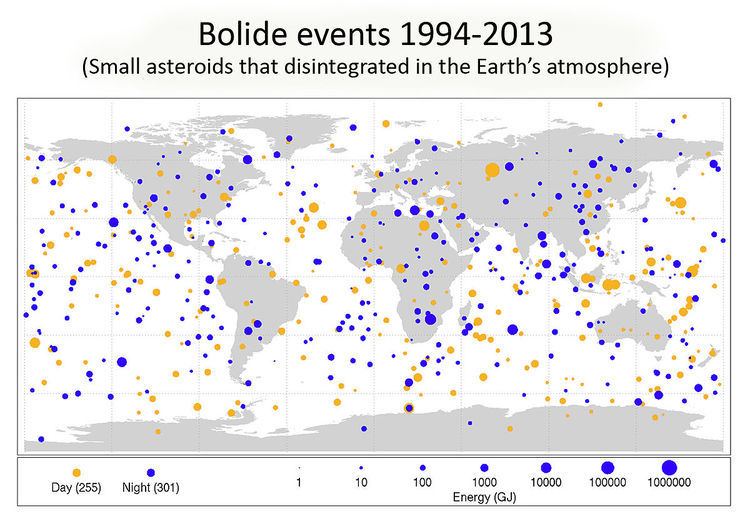 | ||
Many explosions have been recorded in Earth's atmosphere that are likely caused by the air burst that results from a meteor burning up as it hits the atmosphere. These types of meteors are also known as fireballs (or bolides) with the brightest known as superbolides. Contrary to smaller and common "shooting stars", these larger meteors were originally asteroids and comets of a few to several tens of meters in diameter before impacting with Earth's atmosphere.
Contents
The best known is the 1908 Tunguska event. The appearance of extremely bright fireballs traveling across the sky is often witnessed from a distance, such as the 1947 Sikhote-Alin meteor and the 2013 Chelyabinsk meteor, both in Russia. If the bolide is large enough, fragments may survive such as the Chelyabinsk meteorite. Modern developments in infrasound detection by the Comprehensive Nuclear-Test-Ban Treaty Organization (preparatory commission est. 1997) and infrared DSP satellite technology have increased the likelihood of detecting airbursts.
Frequency
The table from Earth Impact Effects Program (EIEP) estimates the average frequency of airbursts and their energy yield in kilotons (kt) or megatons (Mt) of TNT equivalent.
Events
While airbursts undoubtedly happened prior to the 20th century, reliable reports of such are quite scanty. A relatively well-documented case is the 1490 Ch'ing-yang event which has an unknown energy yield but was apparently powerful enough to cause 10000 deaths. Modern researchers are skeptical about the figure, but the Tunguska event could have destroyed a highly populous district.
Depending on the estimate, there were only 3-4 known airbursts in the 20th century with energy yield greater than 100 kilotons (in 1908, 1930, 1932, and 1963), roughly consistent with the estimate of the EIEP table. Most values for the 1930 Curuçá River event put it below 1 megaton.
The first airburst of the 21st century with yield greater than 100 kilotons came from the 2013 Chelyabinsk meteor, which had an estimated diameter of 20 meters.
The Comprehensive Nuclear-Test-Ban Treaty Organization and modern technology has improved multiple detection of airbursts with energy yield 1-2 kilotons every year within the last decade. To prevent clutter, the table below (arranged chronologically) will include those with yield at least 3 kilotons after year 2005, or smaller if it is noteworthy enough to have been reported in the media like the 2013 and 2014 Argentina events, or meteorite falls such as the 2015 Sariçiçek event in Turkey.
As of 2017, the statistics per year since 2005 for airbursts mentioned by the JPL Fireball and Bolide Reports are,
There was a relatively high number of detected airbursts for the year 2015, some of which were accompanied by meteorite falls listed in the main table.
